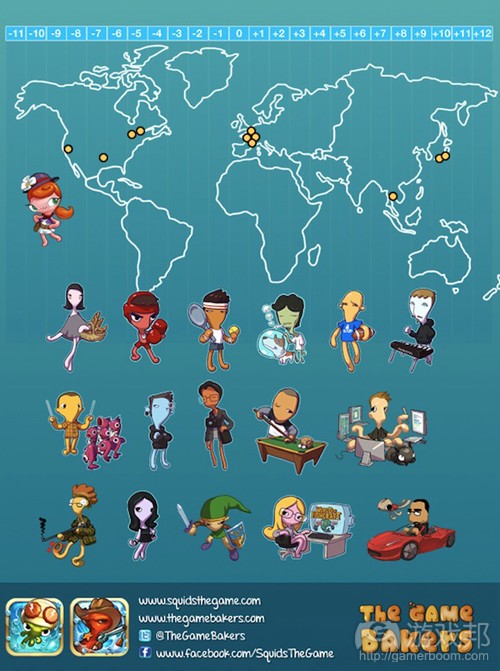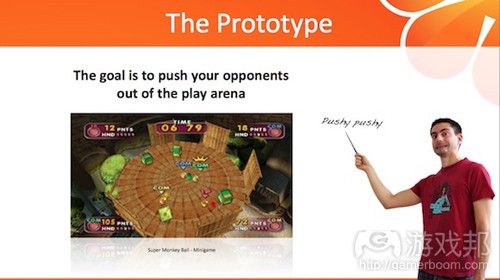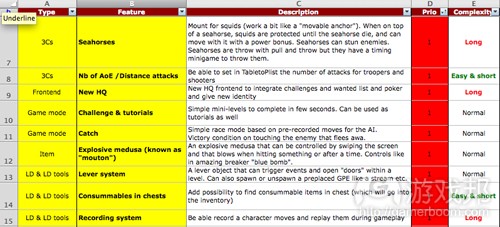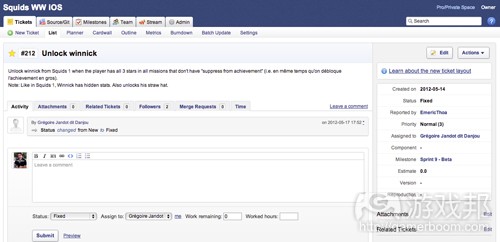Emeric Thoa分享运营虚拟独立工作室的经验
作者:Emeric Thoa
在圣诞假期期间,我就《Squids》的制作历程,以及制作一款iPhone游戏实际所需的预算与盈利情况写了一篇文章。我之所以这么做,是因为在独立开发之初,我尤为关注项目开发的事后分析,而且我认为这类经验分享能够让其他开发者受益。
在转投独立游戏开发前,我希望更多地了解关于运营一家虚拟独立工作室所需的工具与最佳方式。在此,我所说的“虚拟”是指没有正规办公室的游戏工作室。
许多独立开发者都面临过这类状况:即你已在家中启动项目,但却无法租赁一间办公室,或者也可能是,你是一个程序员,而你有个住在其它地方的美术设计合作伙伴。
虽然在1995年,缺少办公室可能会成为游戏制作的一个难题,但现在它不再是阻碍你制作游戏的原因。目前游戏开发渠道多种多样,而运营虚拟工作室也可能成为一种势不可挡的理念。
我钟爱独立开发的一个原因是,我们不仅可以让玩家体验我们开发的游戏,而且还可以同开发者自由地交流游戏创意与开发手段。以下是我们解决The Game Bakers中存在问题的方法,包括如何组建团队,当时利用了哪些工具,以及我们投入了多少运作成本。
全球性工作室
在我看来,“真正的”游戏工作室是指拥有传统办公室,即开发团队可以在某个开放场地分享自己的想法。我之所以称呼The Game Bakers为“虚拟工作室”,是因为我们的团队成员遍布世界各地。虽然每天我们都在一起工作,然而却是来自不同城市、国家甚至大洲的人。
当我还为育碧效力时,我虽然是在真正办公室内工作,但我也有过与其它工作室进行远程合作的经历。比如,《细胞分裂:双重间谍》这款游戏便是由分布在三个大洲的三个团队携手打造;而《幽灵行动:先锋战士》则由来自美国、法国和中国的四个开发团队联合制作。
在创办The Game Bakers之初,我们的目标是利用较小规模的开发团队制作较小型的游戏,但同时,我们也想要制作出具有出色产品价值的高品质游戏,类似我们曾经开发的主机游戏。我们要实现这一目标必须依赖于我们曾合作过优秀人才,但现在他们却分散在世界各地(即使是我们最初在法国的成员,大家彼此间同样相隔甚远)。
与我们了解且欣赏的优秀人才合作能够保证更好的工作效率、较高的工作品质、更顺畅的交流、以及让我们每天的工作充满更多乐趣。为了成立适合日常运行的开发团队,我们必须总结自己过去在远程协作方面的经验。
以下为制作《Squids》和《Squids Wild West》这两款游戏的团队分布情况。
我们的核心团队由分布在2个国家、6座城市的6名成员组成。而整个团队共有19人,他们来自5个国家,而且几乎分布在19个不同工作地区。
核心团队需要全程负责游戏开发,成员包括:
*2名程序员
*1名技术经理兼数据管理人员
*1名美工
*1名游戏设计师/关卡设计师/制作人
*1名关卡设计实习生
*1名工作室主管(游戏邦注:负责资金、法律、HR及市场营销方面)
UI、故事、声效、建模及PR则由兼职同事负责。我们大部分团队都是自由承包者。同比雇佣员工,与他们合作确实为我们带来了方便,因为这样可以节约工作室的开支,但相对而言,他们极不稳定,因为所有成员都可能会随时离开。如果某款游戏的关键部分由所有成员负责,那么他们的离去就会给整个项目带来巨大风险。而减少这种风险的一种办法便是缩短项目的开发时间(少于一年)。另外给予核心成员额外照应也是可取行为。相较于由雇员组成的办公场所,管理远程工作成员之员的信赖感是维持虚拟工作室正常运行的关键任务。
甚至,如果你忽视了兼职人员,只考虑到核心成员,也会给独立团队造成巨大影响,因此,我们应在保持所有人具有同一目标方面多下功夫。而这取决于关键因素——交流。
关于交流的建议与工具
当人们问道:“游戏设计师应具备的最重要品质是什么”时,他们通常料想我的答案是“创意”或者“了解游戏”或者“理解技术与美术方面”。但在我看来,我认为游戏设计师应具备的最重要品质是能够清晰地与人交流,并能通过自己的理念激发团队的工作激情。程序员最难被某个理念打动,但如果他们与游戏设计师交流某个问题后能受到鼓动(比如出现笃定的眼光,蠢蠢欲动打算编写代码这种情况),那就可以看出,你的游戏设计师十分优秀。
向团队传递自己的想法,并付诸努力予以实现,这对真实工作室来说存在难度,而对于无法面对面进行交流的虚拟工作室而言,更是一个巨大的挑战。
交谈是成本低但很有效的手段
在育碧工作期间,有个出色的制作人曾告诉过我:“如果你的邮件内容超过5行,那就拿起电话进行交谈吧。只有胆小鬼才使用邮件;他们误以为这是最佳方法,所以耗费大量时间编写发送内容。打电话就可以了!”
此后,我开始关注这一方法,并逐渐认识到她的说法完全正确。
维持与远程同事的关系尤为关键。语音交流便可办到(它的作用还包括节省时间,能够更加准确地传达信息)。我们团队内部主要使用Skype作为即时通讯与电话会议的工具,而且我们还制定了一系列使用指南:
*在工作期间保持Skype畅通,那样任何人都可以与我们取得联系。
*每天,我们团队成员应保证至少4个小时的在线时间,即使有些成员不得不面临6个小时的时差(比如:巴黎/蒙特利尔)
*Skype上还有文本交流的功能,但如果这类讨论耗时超过2分钟,那么我们应选择电话工具。虽然邮件、文本这类工具会让人觉得更加礼貌,且更加简单,但它却鲜少奏效。
*有时,视频聊天也是不错的选择,但不具多大必要性。因为相对而言,声音更为重要。
*作为制作人和创意总监,每天,我应保证与核心团队成员进行至少一次的交流。
*为了保证团队成员掌握最新的行业动态,核心团队每周都会举行例会,届时成员们可以畅谈自己本周负责的项目。
最后一点十分重要。因为每个人对同一事物的看法各不相同,而且你也没有多余的时间去赶超“见多识广的”人员。为此,周会一般会持续30-45分钟,在此期间,任何人都可以进行自我充电,并提问有关问题。
费用:
-Gmail账户:免费,外加自己的网络域名每年需支付8美元左右
-使用Skype或Google Hangouts进行语音聊天:免费
视频的构成
我极其赞同通过视频呈现游戏设计文档。如果现在我打算创建一个游戏设计奖学金项目,我不会使用MS Word,而会选择采用Final Cut和Photoshop。通过视频分享关于游戏机制或循环玩法的创意尤为简单。而且也为整个团队指明了具体开发方向,成员们也会认真观看这个视频。有谁打算阅读一个长达10页的游戏设计文档呢?没人吧。但人人都乐意投入1分钟的时间观看关于游戏理念的视频。
以下为早期针对《Squids》制作的游戏设计文档。
*Keynote PDF文档中并未过多涉及文字,主要是有关游戏画面与功能的简要概况
*从Google Images上下载图片后,使用After Effects将图片连接起来,制成一个模拟设计视频。虽然这种视频画面十分难看,且动画效果十分糟糕,但却可以呈现出游戏创意。你还可以在视频中看到该创意如何演变成《Squids》这款较完美的作品。
费用:
-在网络上分享视频:免费
通过YouTube或需要密码的Vimeo这类工具与远程同事分享视频既简单又实惠,而且它也印证了远程工作最近10年来发生的变化。
详细说明
一旦我与成员分享该项目的全球创意,我的头脑中立马构造出游戏的一系列功能。通常我会先制定出“难看的”游戏设计文档,而这实际上更像是项目管理。
*按照一定顺序在Excel中列出功能,并囊括了功能时长与预算
*在Assembla中输入标签(按功能规格划分),Assembla是一种在线云端开发工具,支持以灵活方式管理项目
我们只使用Assembla的基本功能。在确定发展目标后,我们将其分成以两周为期限的短期目标(一种“小型目标”,包括既定目标与成果范本)。我会针对每个短期目标写下详细信息,并将它们分解成一系列标签。我们会在制定短期目标之初,与程序员不断检查其中的内容,而且为每个标签贴上相应动态:新型、固定、待定及封闭。这些均为普遍事项。
这种方法完美地匹配了程序员系统性的办公方式。而在美术方面,我们更多地依据一张较简单的Excel项目列表,每周,我们会检查两次项目进程,以便做出适当调整,保证项目正常进行。
文件共享、管理及资源控制
对于视频、文档与美术资源方面,我们主要使用Dropbox,它具有强大的文件托管及服务分享功能,支持在云端同步共享文件夹。
我们大部分团队打算将Dropbox的默认免费空间(2GB)扩充为4GB左右,以便适合我们的目前需求,而美术与设计团队则采用专门账户,因此他们可以存储更大容量的文件,比如高分辨率的PSD。
费用:
-Dropbox 100GB的账户:99美元/年
-Dropbox 2GB的账户:免费(Dropbox还提供了扩充免费空间的多种渠道)
账户密码主要由Assembla托管,而Github用于资源控制。而且事实证明,这两项工具兼具高效性与可依赖性。
我们团队还有一大优势,即所有成员的电脑上均存有完整的本地历史记录,这意味着,基本上我不必连接网络,便可着手进行任务,最重要的是,如果我搞错了服务器上的数据,那么我可以从其他人那获得一个清晰的版本,修复服务器。而这对笨拙的设计师而言尤为有益。
我们在Mac上使用GitX,即采用可视化界面的开放性资源控制系统,借此提交某些更改信息,但还有其它工具也具备这项功能。
费用:
-Assembla“单个帐号”:19美元/月
-GitX或Github:免费
对于新手而言,他们可以利用这些工具在同一时间从事同一个项目,并通过远程服务器整合各自的工作成果,而不必向所有团队发送已更新的文件。
分享游戏版本
我们有必要在数字行业内实行创建项目共享,虽然这对虚拟工作室而言无关难易问题,但我们还是需要想出相应的解决方案。
以下为分配开发项目的一些渠道:
*TestFlight是一项十分方便的服务,它允许你向收件人列表上的名单发送iOS或Adroid版本的游戏。它的使用方法也非常简单,但需要订阅后才能使用,如果你打算向iOS发送专用版本,你需要在设备列表中添加该用户的UDID。
*HockeyApp的用法与TestFlight并无两样,但我们还能用它搜集玩家发送的错误报告。
费用:
-HockeyApp:25美元/月
-TestFlight:免费
野营工作
最后,我们发现优化远程工作的最佳渠道之一便是暂时停止远程模式。我们将这种方式命名为“野营工作”,而其中涉及的方法也十分简单。
适合6-8人团队的工作野营方案
*向他人借住或租用一所大房子,保证可以提供充足的床位。
*保证房子位于安宁的乡村地带,或者靠近海边。
*确保这所房子远离所有成员的家,那么就不会有人在最后一天先行撤退。
*保证可以连接上正常网络。
*房子租期为两周,最好在一个目标最后期限前不久开始实行计划。
*帮所有成员预订机票和火车票。
*准备大量桌面游戏。
*按照自己品味聘请一名专门厨师,或者自己下厨。或者只需翻热披萨!
*确保准备充足的酒水。
*每六个月举行一次野营工作。
野营工作具有众多价值:
人们可以真正地聚在一起工作,而且能够保证他们之间的合作关系在接下来六个月的远程工作中持续发展且发挥作用。
如果团队能在适当时间实行这个计划,那么他们将取得显著效果。在开启一个重要里程碑前,每个团队成员都需面对大量的固定工作。我们发现在这种情况下,每人每天的工作时间达到10小时,而后在夜晚享受美好的午休时间和游戏时间。在我们看来,两周的野营工作取得效果不亚于三个星期的正常上班。
这纯粹是为了培养成员的感情与工作激情。与团队分享独立开发时间、游戏时间以及吃喝时间总是趣味无穷,但能举办某些意外活动就更棒了。事实上,野营工作打破了常规事项,所以这是个出色的方案,值得我们投资。
以下是我们野营工作成本:
费用:
-交通:取决于各自团队。我们大约花费了1200美元。
-住宿:我们设法借住同一个地方。所以每次支付1500美元(两周的活动)。
-食物:300美元(每人每天支付10美元伙食费,其它部分由工作室负担。基本费用都在酒水上。)
我们在推出一款游戏后也会举行庆祝派对。下图是我们发行《Squids》后,进行的“烘焙/鱿鱼烹饪的工作间”:
优缺点总结
以下是关于成立虚拟工作室的最后一些经验:
优势:
*聘请全球人才的方式更加简单
*减少办公室租赁费用
*灵活安排开发进程
*无需出差
*比开放场所更加安静
每周,我都非常感激自己在家办公的日子。比如,我会在早上11点时出去买东西,但我在公司办公的7年里从未做过这类事情。还有,我可以不受干扰地连续4小时专注我的工作。然而,当我还为育碧效力时,每隔15分钟,总会有人向我咨询问题。虚拟工作室确实更具活力!
劣势:
*需要经验丰富的核心团队,且团队成员具有极大的自制力
*需要拥有安静家庭环境的专门人才
*沟通障碍会降低生产效率
*虽然进行技术项目远程控制并无难度,但美术与游戏设计项目则需要团队之间更顺畅的沟通
*工作之余无法与好友喝上一杯!
即使整个团队运行出色,且所有成员都参与到虚拟工作室的组建,但你仍会怀念真正工作室中的舒适感。你还会遇到Skype语音质量问题。也可能想在白板上画些东西(游戏邦注:游戏设计师钟爱白板),但目前为止,网络白板却无法给你带来这种感觉。
起初,人们并不认同成立虚拟工作室,但全球性独立工作室的出现表明,我们有必要发展虚拟工作室:现在,游戏制作已不再受到国界限制。
同时,“真正工作室”也具有大量优势,不久之后,我们可能会在The Game Bakers内部成立混合团队。然而至今,The Game Bakers已经支持我们实现了创办自己的工作室、制作自己的游戏和IP的梦想。
除了数字发行渠道的盛行,虚拟工作室也将能够成为开发者自由创作并以此谋生的重要支持因素。我希望,自己的经验分享有助于独立开发者着手尝试这一做法。(本文为游戏邦/gamerboom.com编译,拒绝任何不保留版权的转载,如需转载请联系:游戏邦)
A Game Studio in the Clouds
by Emeric Thoa
How does an indie studio come together — and ship games together — if they’re not located in the same city? Emeric Thoa, former Ubisoft developer and current creative director of The Game Bakers, explains what tech and techniques can make it work.
The last time I had a second of free time was over the Christmas holidays and I used that free time to write a paper about our experience making Squids and the realities of budget and profitability for an iPhone game. I wrote this postmortem because when I started as an indie, I would have loved to have such information, and I felt it was useful to share with other developers.
I was amazed by the attention it got, and I was very pleased to read all the nice comments about the article. And for those who asked: no, it didn’t have a visible impact on Squids’ sales, but it generated 24k unique visitors to our website in three days, which made the article more visible on Google and made the information more available to the industry, and that’s always a good thing.
There’s something else I would have loved to know more about before diving into indie game development: the tools and best practices for running a virtual indie game studio. By “virtual”, I mean a game development studio that doesn’t have an office.
This is a situation shared by many indies: you start your project from home and don’t have the budget for renting an office, or maybe you’re a programmer and you have an artist buddy who lives in a different place.
Lack of an office might have been a problem in 1995, but it shouldn’t prevent you from making games anymore. The problem nowadays is that there are so many ways to do it, the idea of running a virtual studio can be overwhelming.
One thing I love about indie development is that it’s not only about having people play our games, but also about developers freely exchanging ideas about our work and methods. So here is a bit of information about how we’ve tackled this issue at The Game Bakers, how we are organized, what tools we’re using at the moment, and how much this stuff costs us.
The Global Game Bakery
When I think of a “real” game studio, I think of a traditional office with an open space shared by the development team. I call The Game Bakers a “virtual studio” because we are spread out around the world. The team works together all day, but remotely from different cities, countries, and even different continents.
When I was working at Ubisoft, of course I was working in real offices, but I also had a lot of experience working remotely with other studios. Splinter Cell Double Agent was made by three teams spread across three continents; Ghost Recon Advanced Warfighter was made by four teams in the U.S., France, and China.
When we started The Game Bakers, we wanted to make smaller games with a smaller team than we had at Ubisoft, but we also wanted to create high quality games with good production values, like the console games we had worked on. One of the cornerstones of this ambition was to rely on a network of talented people whom we had worked with before on console games, but who were now spread out all across the world. (Even our initial members in France were not living close to each other.)
Working with these talented people we already knew and liked would guarantee better efficiency, higher quality, smoother communication, and it would make our work more fun on a daily basis.
To set up a structure that would work for day-to-day operations, we had to draw upon our past experiences with remote collaboration.
Here is our team for Squids and Squids Wild West.
The core team is made up of six people spread out in six cities, in two different countries. The total team is 19 people, five countries, and almost as many workplaces as people on the team.
The core team, working full time on the games, includes:
2 programmers
1 technical manager / data manager
1 artist
1 game designer / level designer / producer
1 level design intern
1 studio manager (funding, legal, HR, marketing)
UI, story, audio, modeling, and PR were handled by part time coworkers. Most of the team is freelance contractors. Working with contractors instead of employees is convenient in that it saves a bit of money for the studio, but it’s very uncertain, as anyone could leave the team at anytime. That’s a huge risk for a project where everyone is responsible of a key aspect of the game. One way to reduce this risk is to keep the projects short (shorter than a year). Being extra nice to them also doesn’t hurt. Managing trust is a much more important task in a virtual studio with distant contractors than in an office where everyone is an employee.
Even if you forget the part time people and just consider the core players, this is pretty big for an indie team, and a bit of work and effort is required to keep everyone moving in the same direction. The key word here is communication.
Communication Tips and Tools
When people ask me, “What’s the most important quality in a game designer?” they often expect me to answer “creativity” or “knowing games” or “understanding both the technical stuff and the art stuff”. But I actually think the most important quality is being able to communicate clearly and to fire up a team with your concept. Programmers are some of the hardest people to get excited about a concept, but if they get all fired up after asking the game designer a questio — with shinning eyes and fingers itching to start typing some code — that’s how you know you have a good game designer.
Communicating your vision and having the energy to make it happen is already difficult when your team is all working from the same place, and it can become a huge challenge when you never see these people face to face.
Talk is Cheap… But Effective!
At Ubisoft, I had this great producer who told me once, “If your e-mail is longer than five lines, just pick up the phone and call. E-mails are for cowards; they create misunderstandings and take a long time to write. Just call. Do it!” I started to pay attention and realized that she was absolutely right.
It’s crucial to maintain human relationships with your remote coworkers. Voice chat allows that (in addition to saving time and being a more precise way to communicate). Within the team, we use Skype for instant messaging and conference calls, with a set of guidelines:
We always turn Skype ON when working, so that everyone on the team can reach us.
Every day, the whole team tries to have at least four hours of time that we’re all online, even if some of us have to deal with a six-hour time difference (ex: Paris / Montreal).
When text-chatting on Skype about a feature, if the discussion takes more than two minutes,we move to a call. Like e-mails, text chatting can feel nicer and easier, but it’s really less productive.
Video chat is nice sometimes, but really it isn’t necessary. Voice matters much more.
As the producer and creative director, I try to talk to everyone on the core team at least once a day.
To keep everyone updated, the whole core team has a weekly meeting, during which everyone explains what he or she did during the week.
This last point is very important. How much someone sees of the big picture can be vastly different from person to person, and there’s no water cooler where you can catch up with the more “informed” members of a virtual studio. The weekly meeting lasts between 30 to 45 minutes, and everyone is updated and has the opportunity to ask questions.
Cost:
- Gmail account: Free + around $8/year for your own domain name
- Skype or Google Hangouts voice chats: Free
A Video is Worth a Thousand Pictures
Regarding game design documentation, I’m a big advocate of videos. If I were creating a game design scholarship program right now, I would trash MS Word and replace it with Final Cut and Photoshop. Sharing your vision for a game mechanic or a gameplay loop is way easier with a video. It gives the whole team a concrete direction… and the whole team actually watches it. Who wants to read a 10-page game design document? Not everyone on your team. But everyone wants to watch a one-minute game concept video.
Here are examples of early game design documents I did for Squids.
Keynote PDF files with very little text, includes a generic overview of the features and VISUALS.
A mock-up video made mainly with pictures borrowed from Google Images and assembled in After Effects. It’s ugly, it’s badly animated, but it gives an idea of the game. In the video you’ll also see how it evolved to become the much prettier game that Squids is.
Cost:
- Sharing a video on the internet: Free
Sharing this video to remote coworkers is super easy and free with YouTube or even password restricted Vimeo, and is a good example of how much remote work has changed in the last 10 years.
Getting Into Details
Once I have shared my global vision of the project and I have a set of features in mind, I usually start on the “ugly” documentation — which is more project management, actually.
A feature list in Excel, prioritized, and with a timeline and budget.
A list of tickets (features specifications chunked) entered in Assembla, an online Cloud development tool that allows managing projects in an Agile kind of way
Our use of Assembla is pretty basic. We define milestones that we split into two-week sprints (a sort of “mini-milestone” with defined objectives and a working version). For each sprint I write a bunch of specs and break them down into tickets. We review them with the programmers at the beginning at a sprint and each ticket has a status: new, fixed, pending, closed. The usual stuff.
This works perfectly for the programmers, since their work is very systematic. For art production, we rely more on a simpler Excel task list and we try to check in on progress twice a week, in order to reprioritize and keep the project moving.
File Sharing, Versioning, and Source Control
For all videos, documents, and art resources, we use Dropbox. For those who don’t know about Dropbox, it’s a great file hosting and sharing service that basically allows you to share a folder from your computer with others, and syncs it in the Cloud.
For most of the team we managed to increase the default free space (2 GB) to around 4 GB, which is enough so far, and for the art and design team we have pro accounts so that they can store bigger files like high-resolution PSDs.
Cost:
- Dropbox 100 GB account: $99/year
- Dropbox 2 GB account: Free (and Dropbox offers a lot of ways to increase the free space).
The code is hosted on Assembla, and we use Github as a source control tool. It’s proven to be very efficient and reliable.
One big advantage is that everyone has a repository with complete version history locally on his or her computer, which basically means that I don’t need to be connected to the internet to commit some work, and most importantly, if I somehow screw up the server data, there will always be someone with a clean version that we can restore. For a clumsy designer, it feels safer.
We use GitX on Mac — an open source version control system with a visual interface — to commit our changes, but many other tools exist too.
Cost:
- Assembla “Single plan”: $19/month.
- GitX or Github: free.
For beginners, what all this means is that all the team can work at the same time, on the same project, and then merge everyone’s work together on a remote server instead of having to send manually updated files to the whole team.
Sharing Versions of the Game
Sharing builds is a universal need within the digital industry and it’s not really any easier or harder for virtual studios, but it is something we needed a solution for.
We have several ways to distribute a development build.
TestFlight is a very convenient service that allows you to send an iOS or Android version to a list of recipients. It’s very easy to use, but it requires the users to subscribe, and if you want to send an ad-hoc build on iOS, you will need to add the user’s UDID to your list of devices.
HockeyApp does more or less the same, but we also use it to get crash reports from our players.
Cost:
- HockeyApp: $25/month.
- TestFlight: free.
Workcamps, and Getting Drunk Together
Finally, one of the best ways we’ve found to improve remote work is to stop being remote for a while. We call this a “workcamp”, and the recipe is pretty simple.
Workcamp Recipe, for a Six to Eight Person Team
Rent, or find someone to lend you, a big house with enough beds for everyone.
Make sure the house has a peaceful, countryside location, or is close to the sea.
Make sure it’s far away enough from anyone’s home that nobody can go home at the end of the day.
Make sure you’ll be able to get a decent internet connection.
Book the place for two weeks, preferably soon before a milestone deadline.
Book plane and train tickets for everyone.
Bring a lot of board games.
According to your taste, bring a dedicated cook (like we did twice) or prepare to cook yourself (knowing that you’ll lose at least two hours of worktime a day). Or just warm up pizzas!
Make sure you won’t run out of wine and beer.
Repeat every six months.
The values of a workcamp are numerous:
People get to work together for real, and that bonding will last and prove useful for the next six months of remote work.
It’s also extremely productive if done at the right time. Before an important milestone, work is usually well-defined and everyone has a lot to do. We’ve found that in this setting, everyone is fine working 10 hours a day, with a nice lunch break and a little game time at night. For us, a two week workcamp is as productive as three weeks of normal work.
It’s simply the spirit. Sharing indie dev time, game time, and food and drink time with your team is always fun, but it’s especially cool when there’s something exceptional about it. The simple fact that the workcamp breaks the routine makes it cool, and worth the financial investment.
Here is a short sample of our workcamps:
Cost:
- Transportation: Depends on your team. For us, it’s around $1200.
- Housing: we managed to borrow a place a few times. We rented a great place once for $1500 for two weeks.
- Food: $300 (everyone chips in $10/day, and the studio pays for the rest. Basically, for the wine.)
We also have celebration parties when we ship a game. Here is the “baking / squid cooking workshop” we did after Squids’ release:
The pros & cons in short
Here is a last bit of experience regarding virtual studios:
Pros:
Simplified ability to hire worldwide talents
Reduced office costs
Schedule flexibility
No travel time to the office
More quiet than an open space
Every week, I find myself in a situation where I really appreciate working from home. For instance, going out to buy something at 11am is something I didn’t do for the seven years I worked in a company office. Another example is the ability to focus on work for four hours without being interrupted. When I was at Ubisoft, I had someone coming to my desk asking for something every 15 minutes. Lively, for sure!
Cons:
Requires an experienced core team, with very autonomous people
Requires dedicated people (serious workers) with calm home offices
Reduces productivity due to harder communication
Although technical tasks are easy to manage remotely, art and game design tasks need even better communication
Can’t get a beer with your buddies after work!
Even if the team works well together and everyone’s on board with the virtual studio organization, you will still miss some of the comfort of a real studio. Skype voice chat quality problems might occur. You might also feel the need to draw something on a whiteboard — game designers love whiteboards — but online whiteboards have not been a great solution so far.
At first glance it might seem like a virtual studio isn’t worth it, but the point about having a worldwide team alone makes virtual studios a growing necessity: today, making games is frontierless.
“Real studios” are great for many reasons, and sooner or later we might move to some sort of hybrid organization here at The Game Bakers. But so far, the virtual studio has allowed me and my team to follow our dream of creating our own studio, our own games, and own our IPs.
Alongside digital distribution, a virtual studio organization is a major factor why it’s now possible to make games with total creative freedom and earn a living from it. I hope sharing our methods will help some other indies who might otherwise have been scared off without even trying.(source:gamasutra)













































 闽公网安备35020302001549号
闽公网安备35020302001549号